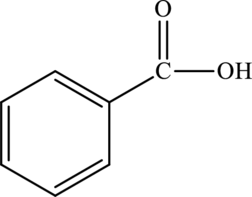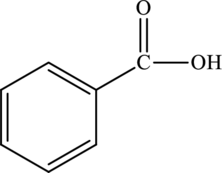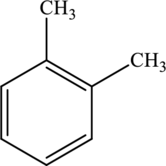
(a)
Interpretation:
The statement “benzoic acid is an aliphatic
(a)
Answer to Problem 6MCP
The given statement is false because benzoic acid is an
Explanation of Solution
Benzoic acid is the simplest aromatic carboxylic acid. It is aromatic due to the presence of a benzene ring in its chemical structure.
The structure of benzoic acid is,

The statement “benzoic acid is an aliphatic carboxylic acid” is false because it is an aromatic carboxylic acid due to the presence of benzene ring.
(b)
Interpretation:
The statement “benzoic acid has a lower boiling point than benzaldehyde” has to be indicated as true or false. The reason for the false statement has to be described.
(b)
Answer to Problem 6MCP
The given statement is false because benzoic acid has higher boiling point than benzaldehyde due to strong intermolecular hydrogen bonding and strong dipole-dipole interactions.
Explanation of Solution
Benzoic acid is a carboxylic acid and benzaldehyde is an aldehyde.
Carboxylic acids have strong intermolecular hydrogen bonding with each other and strong dipole-dipole attractions.
The presence of polar carboxyl group and intermolecular hydrogen bonding makes these acids have higher boiling points. The presence of dimers increases the strength of the van der Waals dispersion forces, which makes them have high boiling points.
Therefore, benzoic acid has higher boiling point than benzaldehyde due to strong intermolecular hydrogen bonding and strong dipole-dipole interactions.
Hence, the statement “benzoic acid has a lower boiling point than benzaldehyde” is false.
(c)
Interpretation:
The statement “benzoic acid reacts with ethanol to form ethyl benzoate” has to be indicated as true or false. The reason for the false statement has to be described.
(c)
Answer to Problem 6MCP
The given statement is true.
Explanation of Solution
Benzoic acid on reaction with ethyl alcohol produces ethyl benzoate and water.
The

The statement “benzoic acid reacts with ethanol to form ethyl benzoate” is true.
(d)
Interpretation:
The statement “benzoic acid has molecular formula of
(d)
Answer to Problem 6MCP
The given statement is false because the molecular formula of
Explanation of Solution
Benzoic acid is an organic compound with molecular formula of
Hence, the statement “benzoic acid has molecular formula of
(e)
Interpretation:
The statement “benzoic acid is structural isomer of xylene” has to be indicated as true or false. The reason for the false statement has to be described.
(e)
Answer to Problem 6MCP
The given statement is false because the structural isomers of benzoic acids are tropolone, salicyladehyde,
Explanation of Solution
Structural isomers are those with same molecular formula but differ in arrangement of atoms.
The molecular formula of benzoic acid

The molecular formula of xylene is

Both these are not structural isomers with each other.
Hence, the statement “benzoic acid is structural isomer of xylene” is false because the structural isomers of benzoic acids are tropolone, salicyladehyde,
(f)
Interpretation:
The statement “benzoic acid is more water soluble in phenol” has to be indicated as true or false. The reason for the false statement has to be described.
(f)
Answer to Problem 6MCP
The given statement is false because phenol is more water soluble than benzoic acid due to its ability to form hydrogen bond with water molecules.
Explanation of Solution
Phenols are water soluble to some extent. This is due to its ability to form hydrogen bonding with water molecules. However, the large part of phenol molecule is the phenyl group that is non-polar and hence its solubility is limited in water.
Whereas, benzoic acid is insoluble in water because of the presence larger nonpolar benzene ring in the structure that cannot be water-soluble.
The statement “benzoic acid is more water soluble in phenol” is false because phenol is more water soluble than benzoic acid due the ability of phenols to form hydrogen bond with water molecules.
(g)
Interpretation:
The statement “sodium benzoate is food preservative and is produced by neutralization of benzoic acid with sodium hydroxide” has to be described as true or false. If the statement is false, the reason that it is false has to be described.
(g)
Answer to Problem 6MCP
The given statement is true.
Explanation of Solution
The reaction of benzoic acid with sodium hydroxide yields sodium salt of benzoic acid and water. The protons of the acid are removed by the
The reaction is,

The statement “sodium benzoate is food preservative and is produced by neutralization of benzoic acid with sodium hydroxide” is true.
Want to see more full solutions like this?
Chapter 14 Solutions
General, Organic, and Biochemistry
- Indicate the processes in the dismutation of Cu2O.arrow_forward1. Consider these three reactions as the elementary steps in the mechanism for a chemical reaction. 2600 2400 2200 2000 1800 1600 1400 1200 1000 800 Potential Energy (kJ) 600 400 200 0 -200- -400 -600- -800 (i) Cl₂ (g) + Pt(s) → 2Cl (g) + Pt(s) (ii) Cl (g)+ CO (g) + Pt (s) → CICO (g) + Pt (s) Ea = 1550 kJ Ea = 2240 kJ (iii) Cl (g) + CICO (g) → Cl₂CO (g) Ea = 2350 kJ AH=-950 kJ ΔΗ = 575 ΚΙ AH=-825 kJ a. Draw the potential energy diagram for the reaction. Label the data points for clarity. The potential energy of the reactants is 600 kJ Reaction Progress b. What is the overall chemical equation? c. What is the overall change in enthalpy for the above chemical reaction? d. What is the overall amount of activation energy for the above chemical reaction? e. Which reaction intermediate would be considered a catalyst (if any) and why? f. If you were to add 2700kJ of energy to the reaction (e.g. 2700 kl of heat or electricity), would you be able to make the reaction reverse itself (i.e. have…arrow_forwarddraw the enolate anion and the carbonyl that would be needed to make this product through an aldol addition reaction.arrow_forward
- Draw the Michael Adduct and the final product of the Robinson annulation reaction. Ignore inorganic byproducts.arrow_forwardDraw the Michael adduct and final product of the Robinson annulation reaction. Ignore inorganic byproductsarrow_forwardPost Lab Questions. 1) Draw the mechanism of your Diels-Alder cycloaddition. 2) Only one isomer of product is formed in the Diels-Alder cycloaddition. Why? 3) Imagine that you used isoprene as diene - in that case you don't have to worry about assigning endo vs exo. Draw the "endo" and "exo" products of the Diels-Alder reaction between isoprene and maleic anhydride, and explain why the distinction is irrelevant here. 4) This does not hold for other dienes. Draw the exo and endo products of the reaction of cyclohexadiene with maleic anhydride. Make sure you label your answers properly as endo or exo. 100 °C Xylenes ??? 5) Calculate the process mass intensity for your specific reaction (make sure to use your actual amounts of reagent).arrow_forward
- Indicate the product(s) A, B C and D that are formed in the reaction: H + NH-NH-CH [A+B] [C+D] hydrazonesarrow_forwardHow can you prepare a 6 mL solution of 6% H2O2, if we have a bottle of 30% H2O2?arrow_forwardHow many mL of H2O2 from the 30% bottle must be collected to prepare 6 mL of 6% H2O2.arrow_forward
- Indicate the product(s) B and C that are formed in the reaction: HN' OCH HC1 B + mayoritario C minoritario OCH3arrow_forwardIndicate the product(s) that are formed in the reaction: NH-NH, OCH3 -H₂O OCH3arrow_forward21.38 Arrange the molecules in each set in order of increasing acidity (from least acidic to most acidic). OH OH SH NH2 8 NH3 OH (b) OH OH OH (c) & & & CH3 NO2 21.39 Explain the trends in the acidity of phenol and the monofluoro derivatives of phenol. OH OH OH OH PK 10.0 PK 8.81 PK 9.28 PK 9.81arrow_forward
 ChemistryChemistryISBN:9781305957404Author:Steven S. Zumdahl, Susan A. Zumdahl, Donald J. DeCostePublisher:Cengage Learning
ChemistryChemistryISBN:9781305957404Author:Steven S. Zumdahl, Susan A. Zumdahl, Donald J. DeCostePublisher:Cengage Learning ChemistryChemistryISBN:9781259911156Author:Raymond Chang Dr., Jason Overby ProfessorPublisher:McGraw-Hill Education
ChemistryChemistryISBN:9781259911156Author:Raymond Chang Dr., Jason Overby ProfessorPublisher:McGraw-Hill Education Principles of Instrumental AnalysisChemistryISBN:9781305577213Author:Douglas A. Skoog, F. James Holler, Stanley R. CrouchPublisher:Cengage Learning
Principles of Instrumental AnalysisChemistryISBN:9781305577213Author:Douglas A. Skoog, F. James Holler, Stanley R. CrouchPublisher:Cengage Learning Organic ChemistryChemistryISBN:9780078021558Author:Janice Gorzynski Smith Dr.Publisher:McGraw-Hill Education
Organic ChemistryChemistryISBN:9780078021558Author:Janice Gorzynski Smith Dr.Publisher:McGraw-Hill Education Chemistry: Principles and ReactionsChemistryISBN:9781305079373Author:William L. Masterton, Cecile N. HurleyPublisher:Cengage Learning
Chemistry: Principles and ReactionsChemistryISBN:9781305079373Author:William L. Masterton, Cecile N. HurleyPublisher:Cengage Learning Elementary Principles of Chemical Processes, Bind...ChemistryISBN:9781118431221Author:Richard M. Felder, Ronald W. Rousseau, Lisa G. BullardPublisher:WILEY
Elementary Principles of Chemical Processes, Bind...ChemistryISBN:9781118431221Author:Richard M. Felder, Ronald W. Rousseau, Lisa G. BullardPublisher:WILEY





